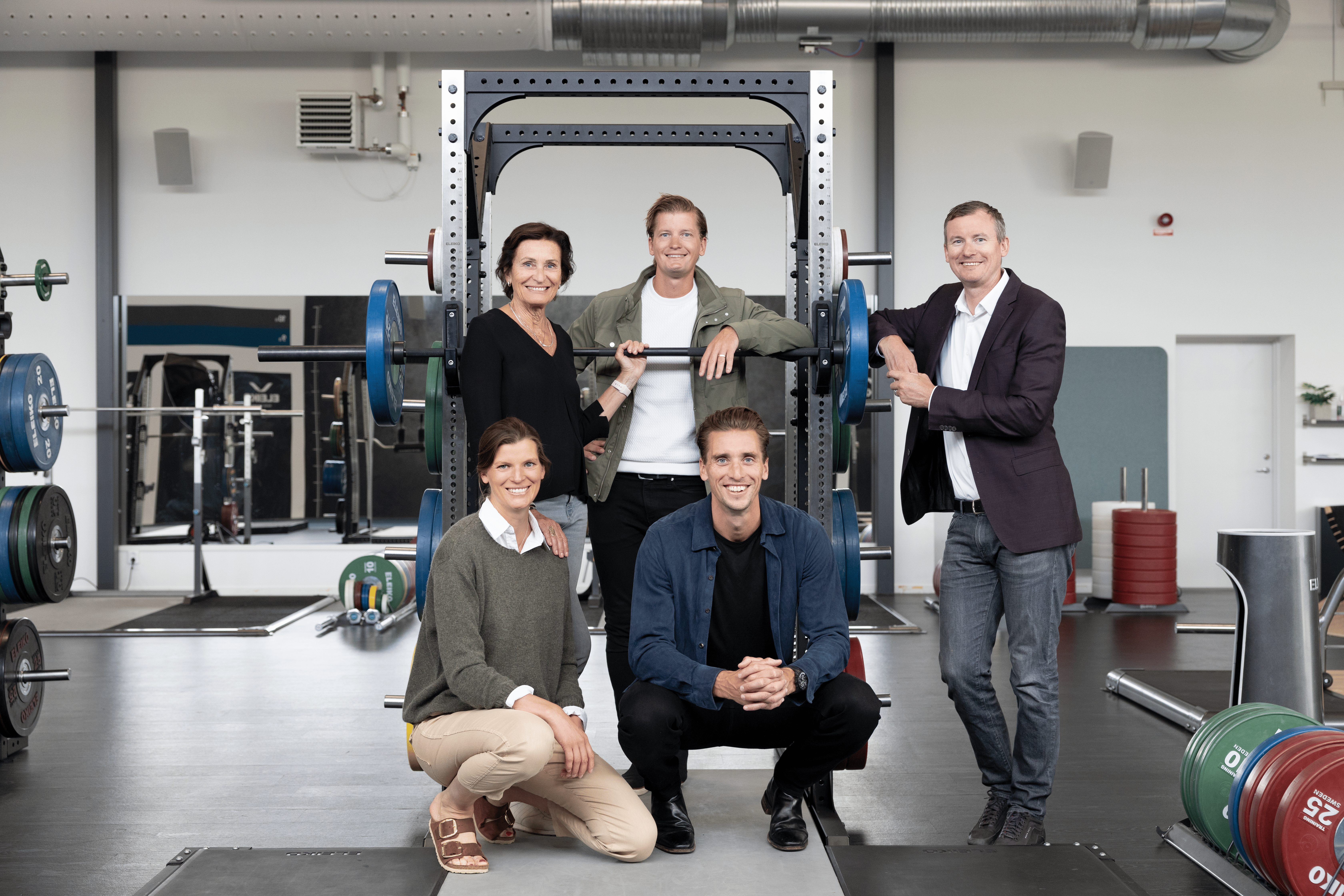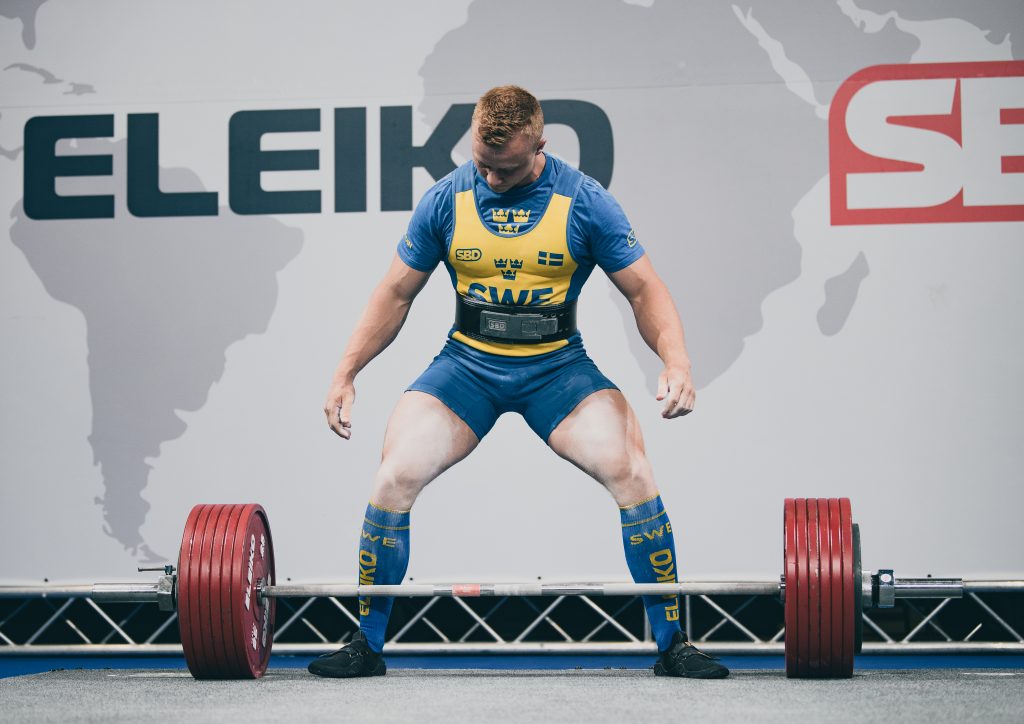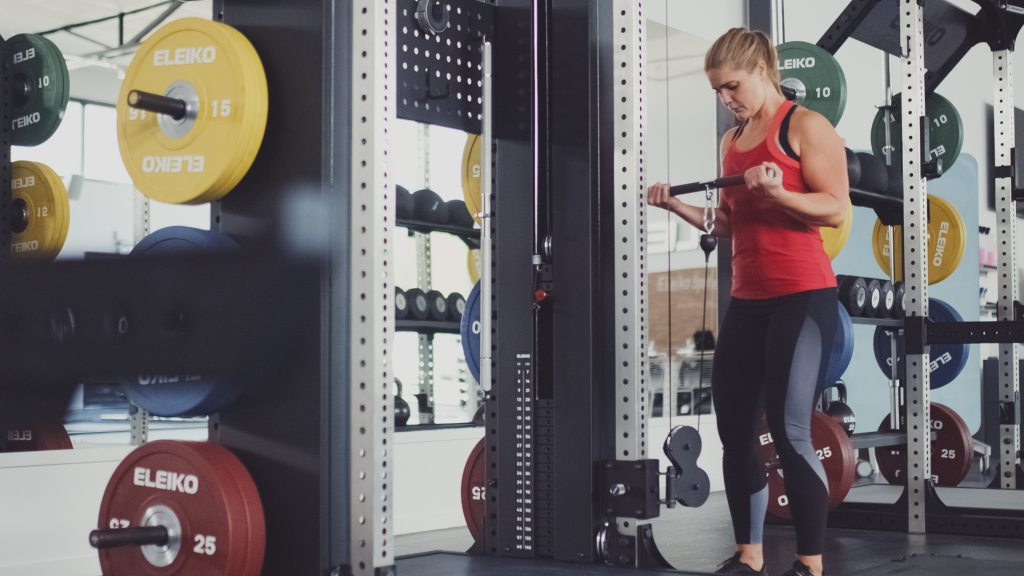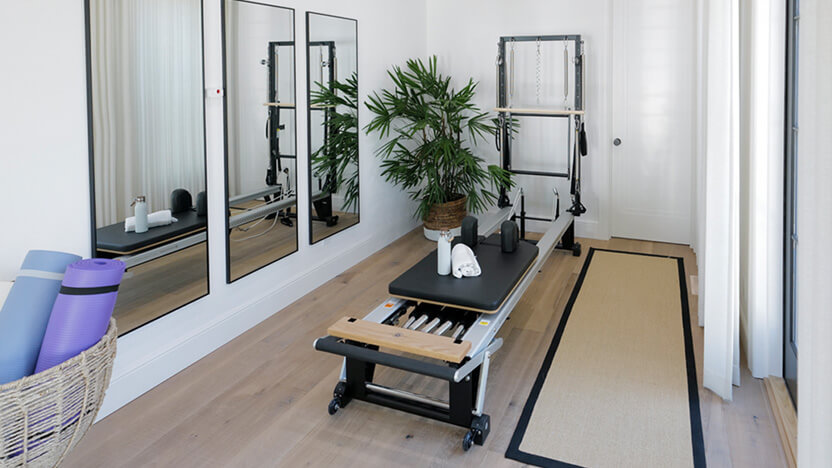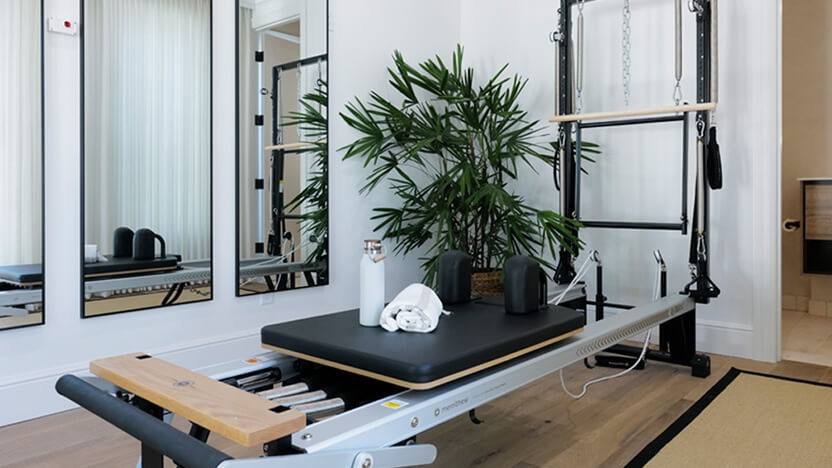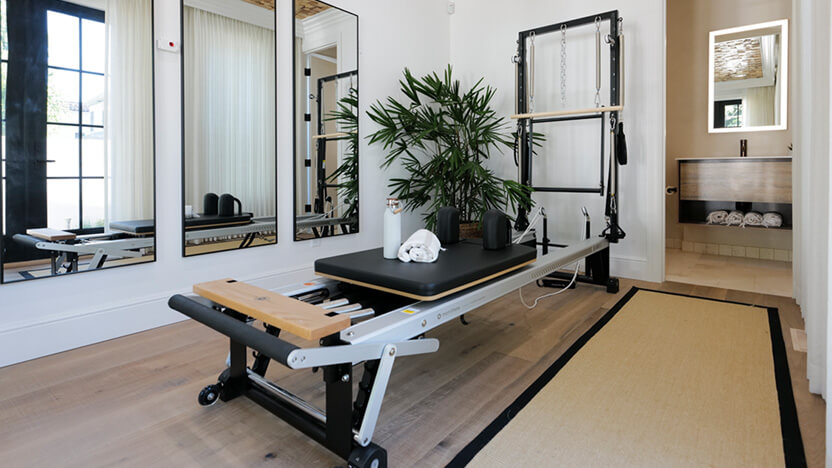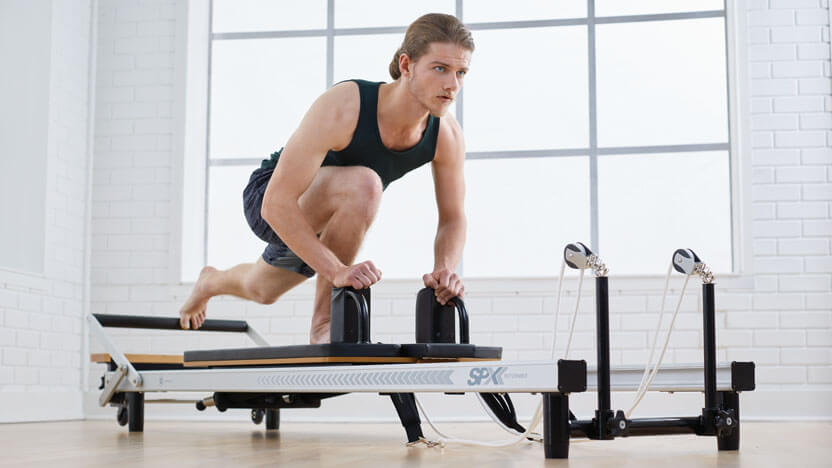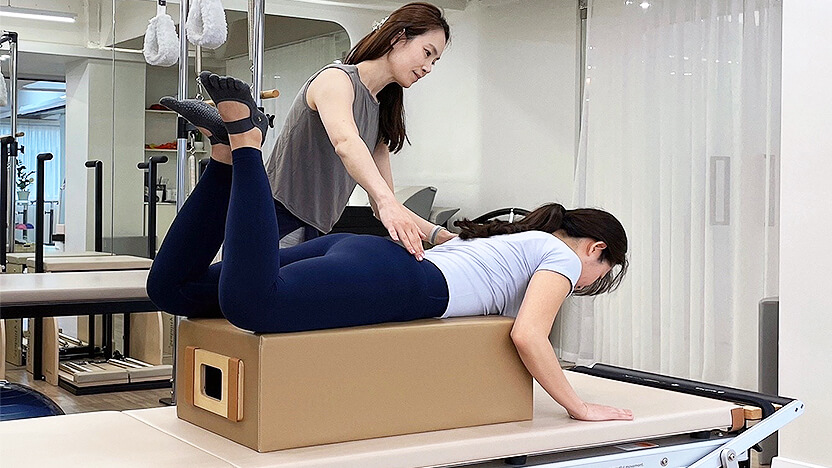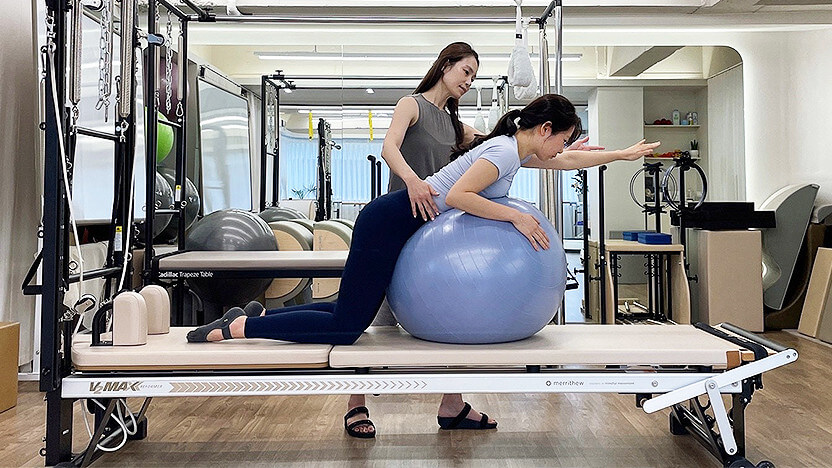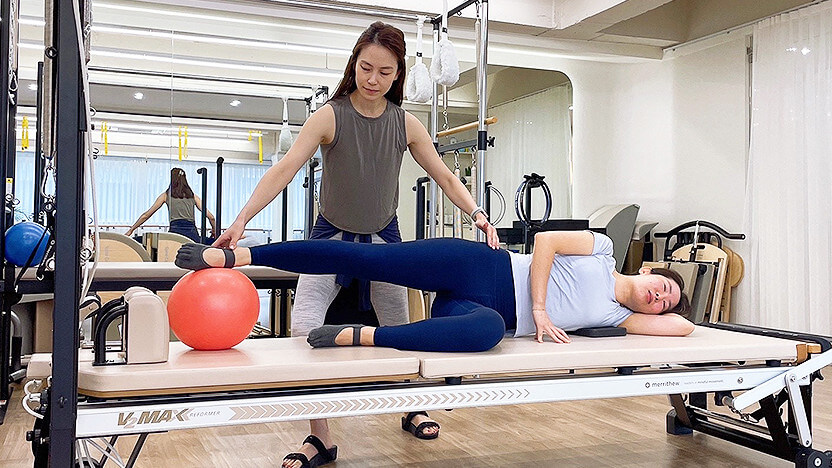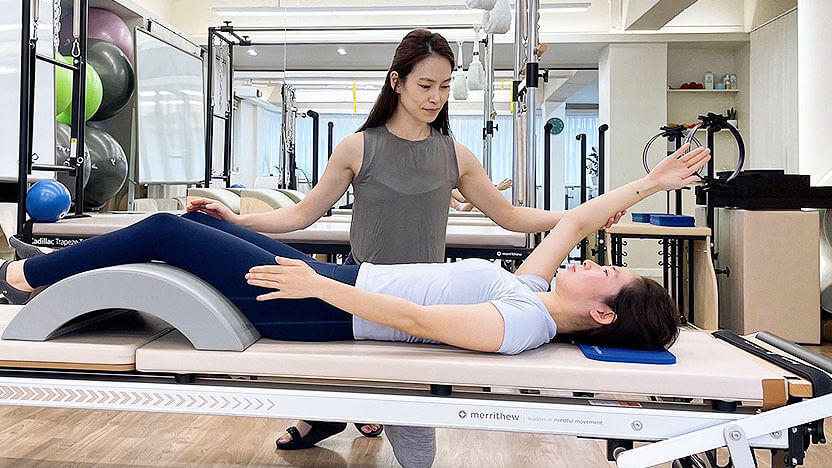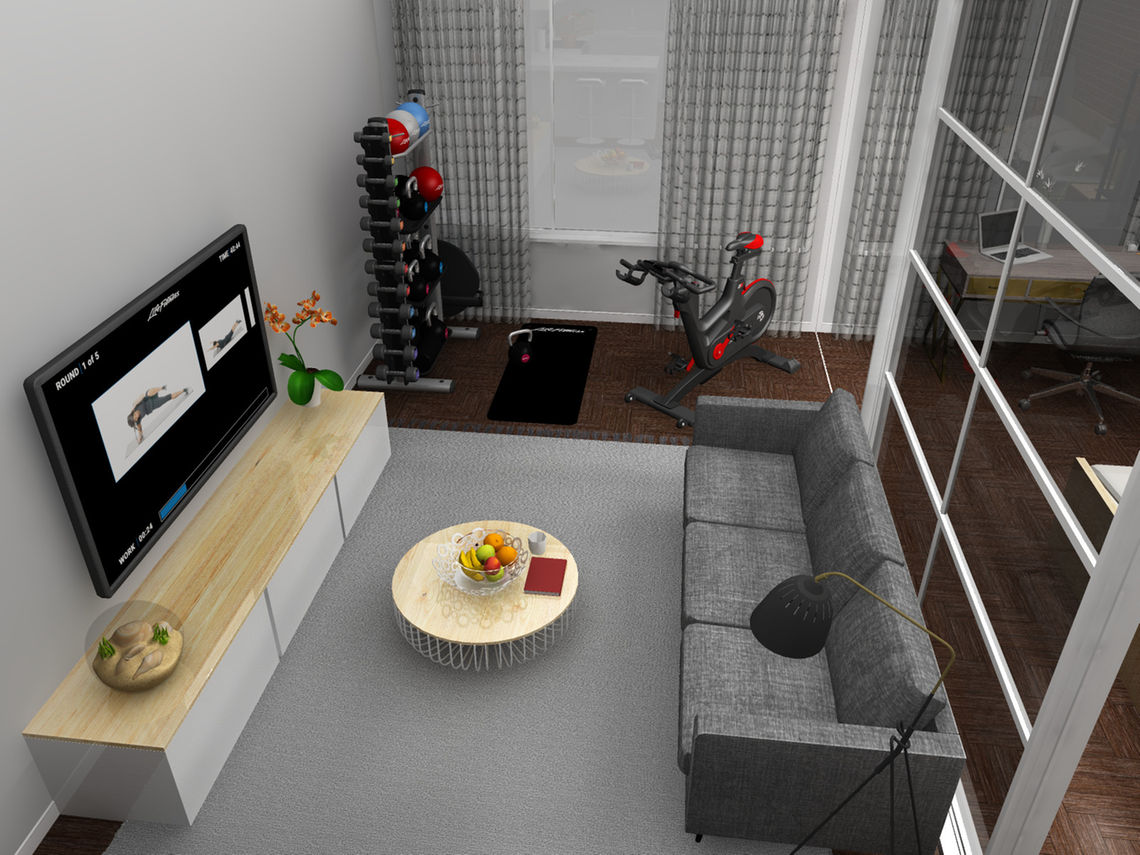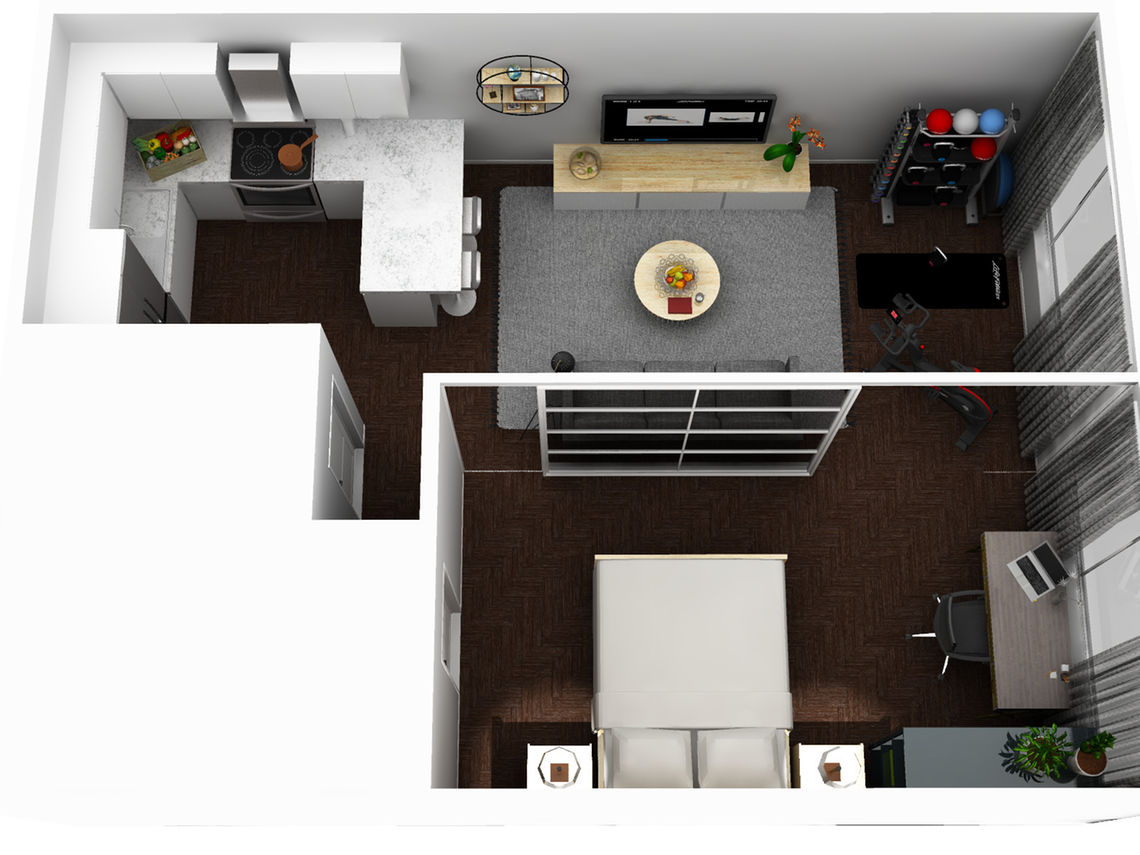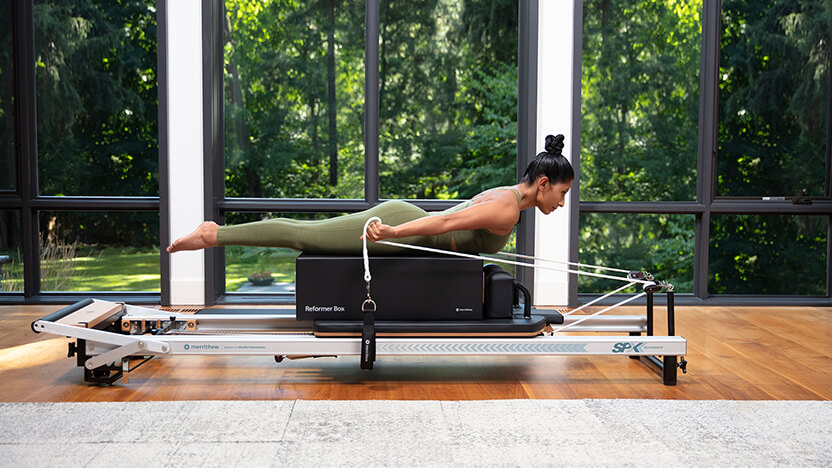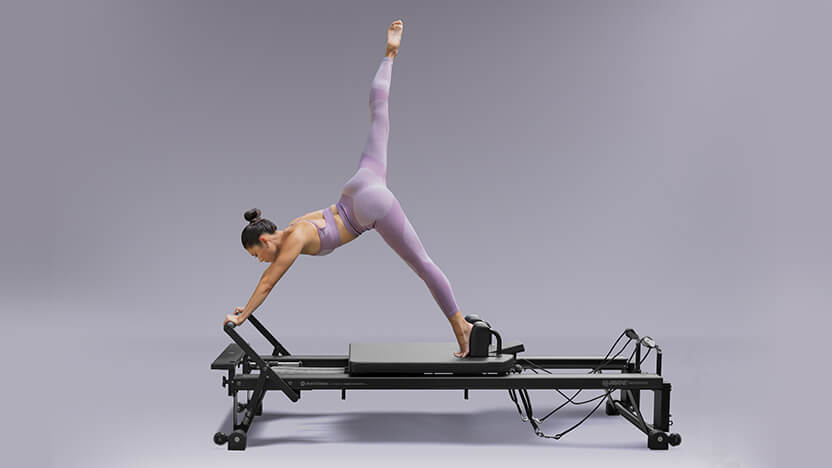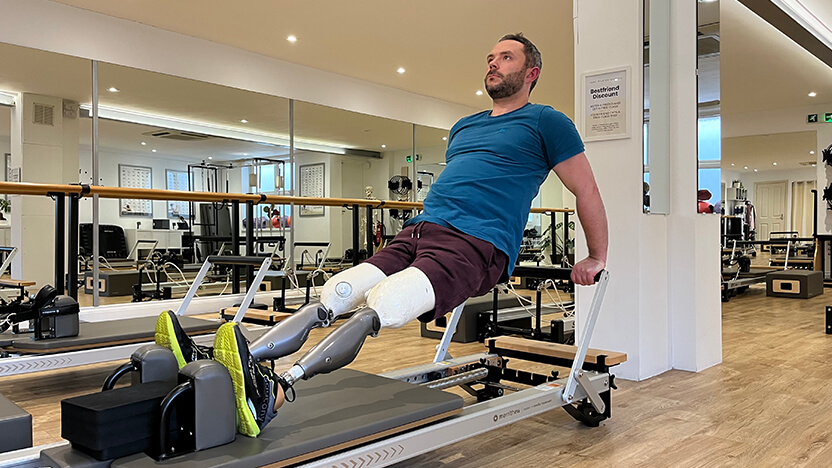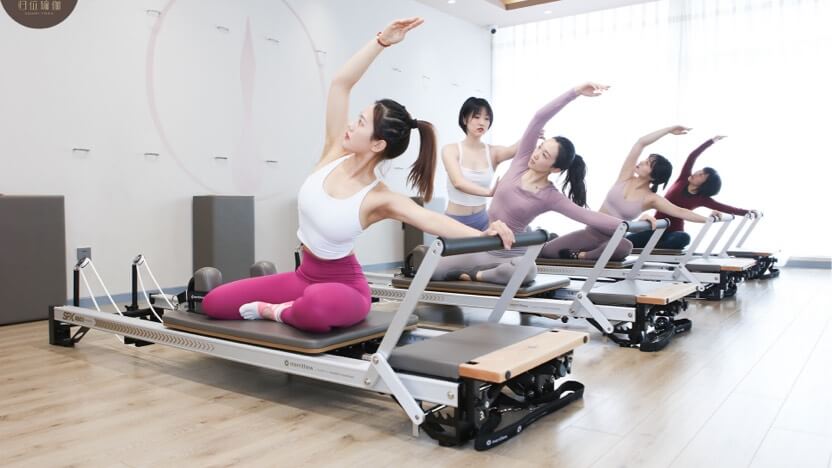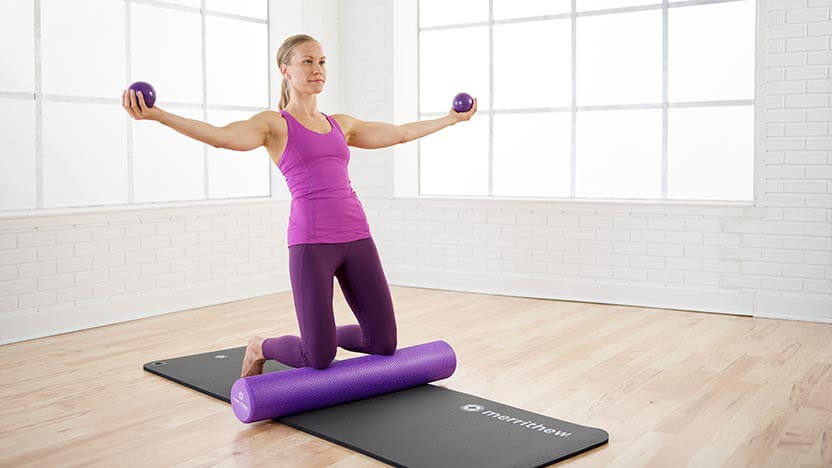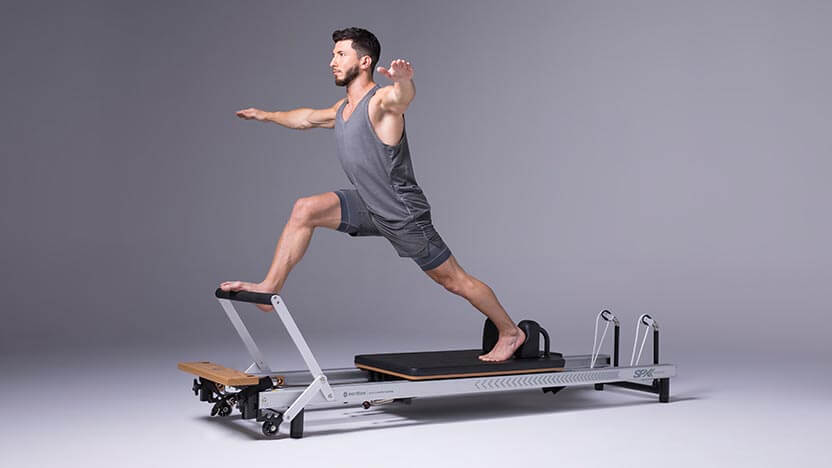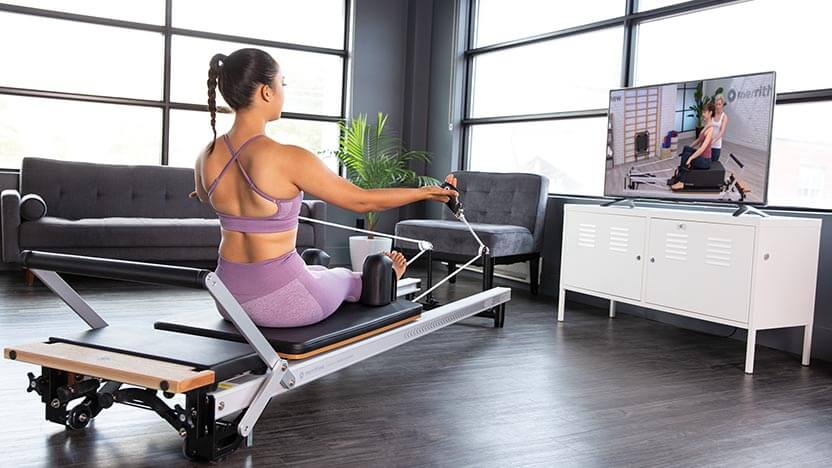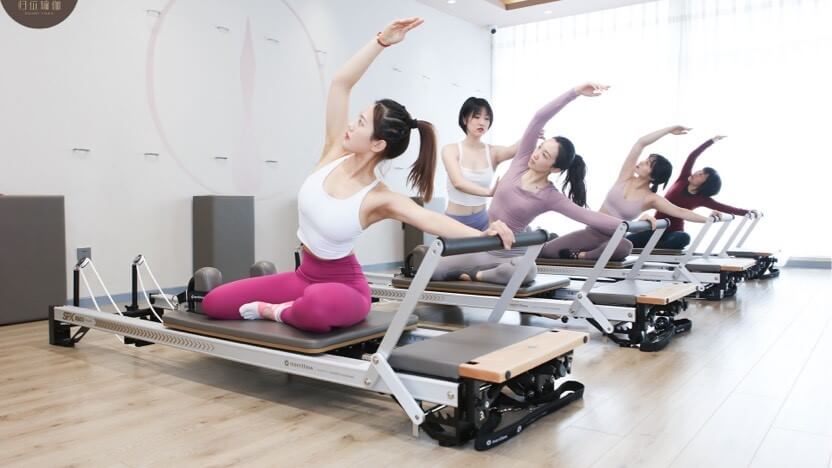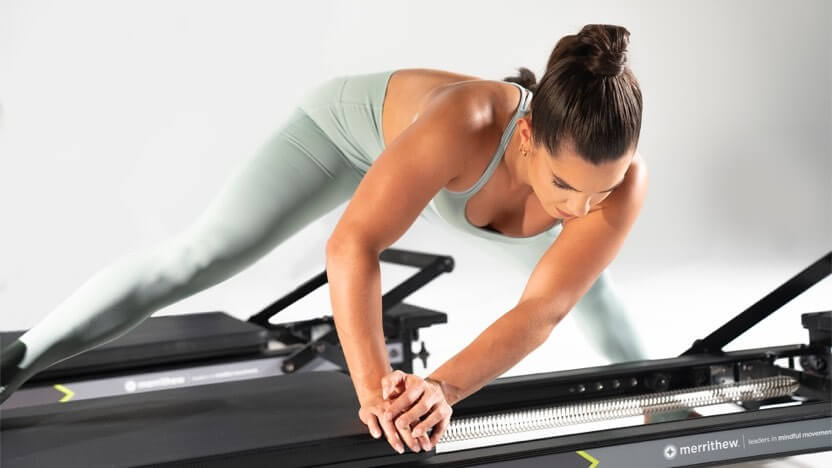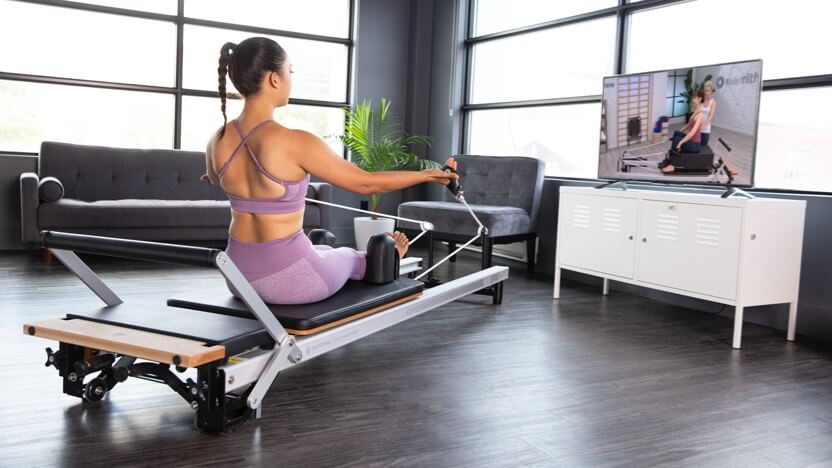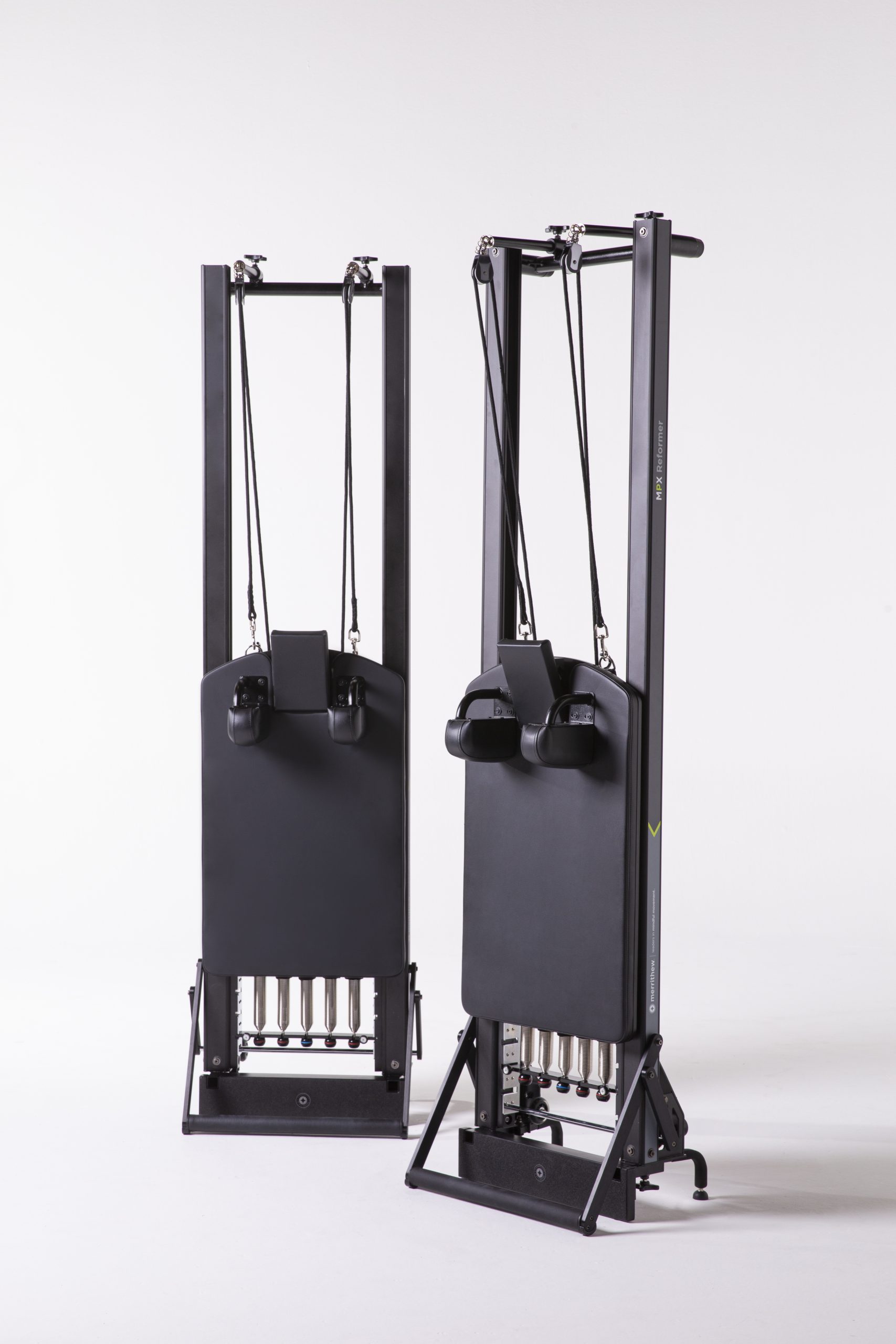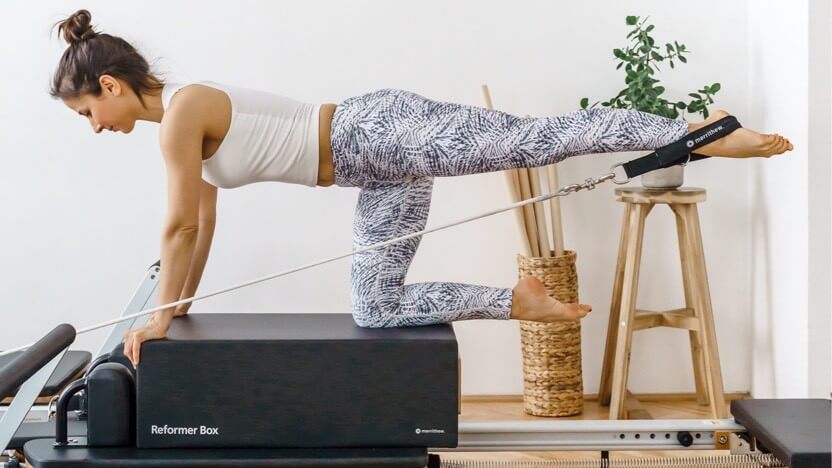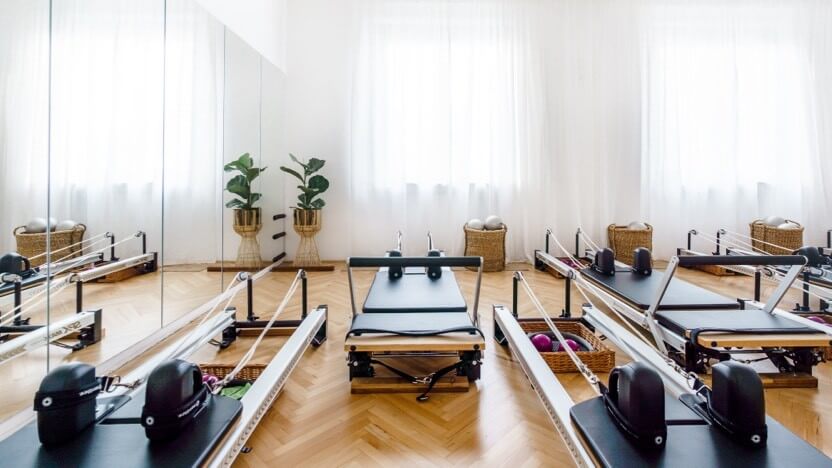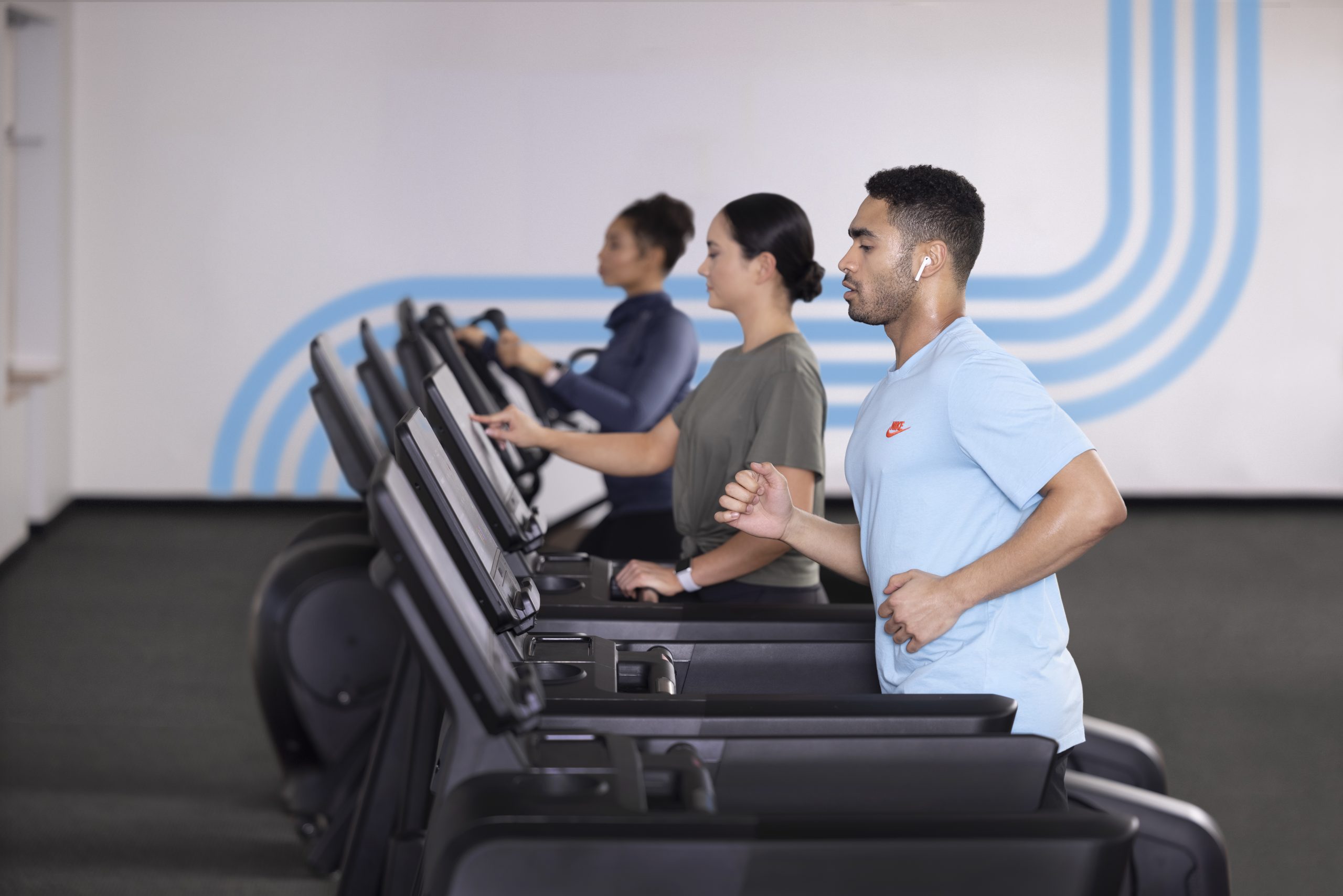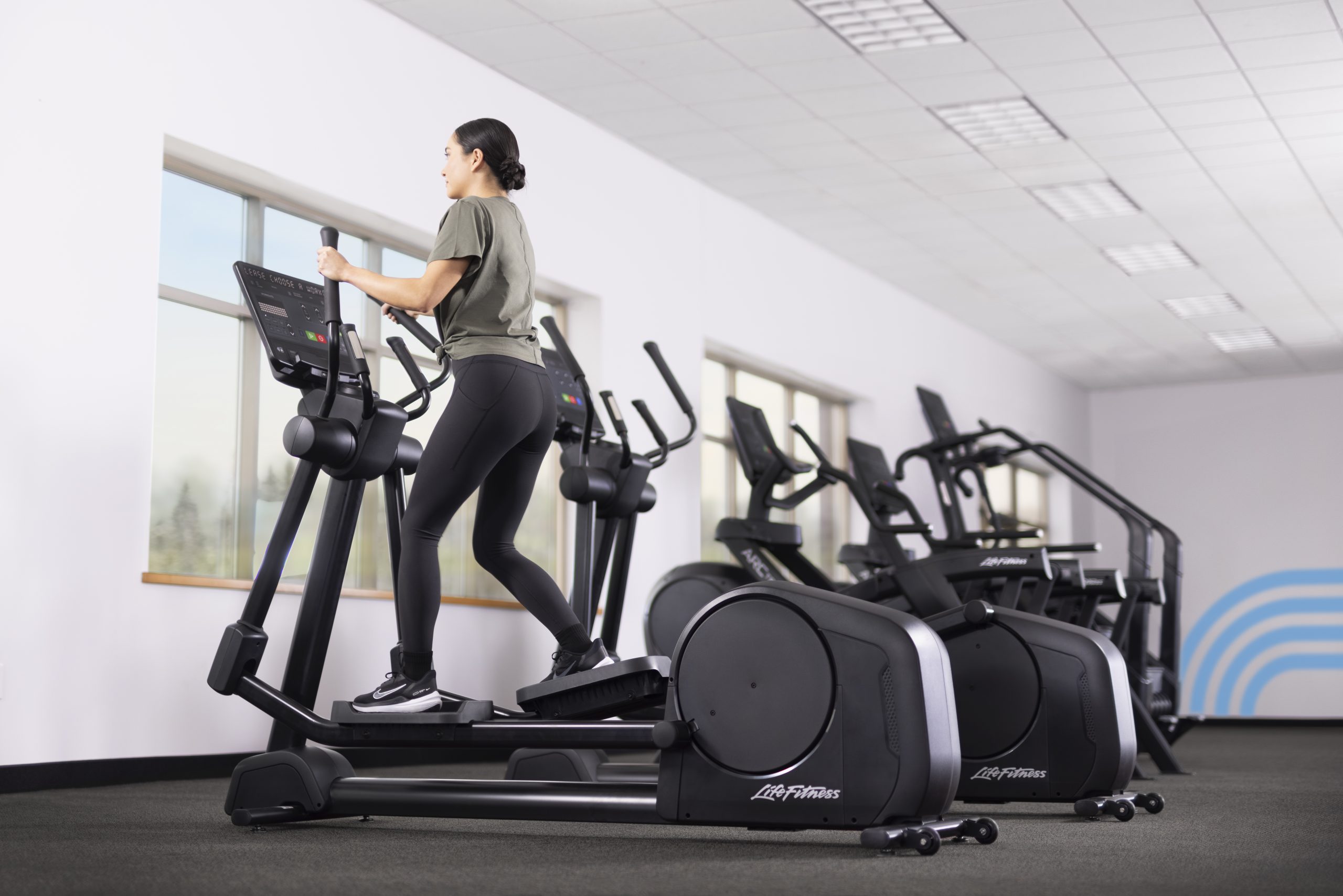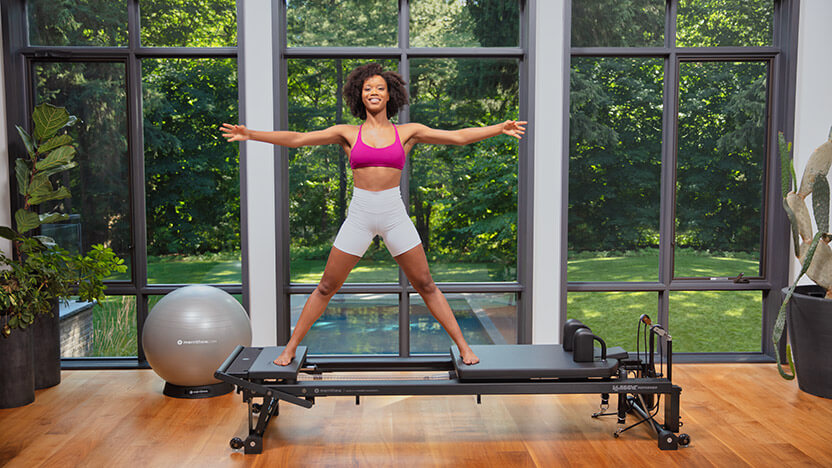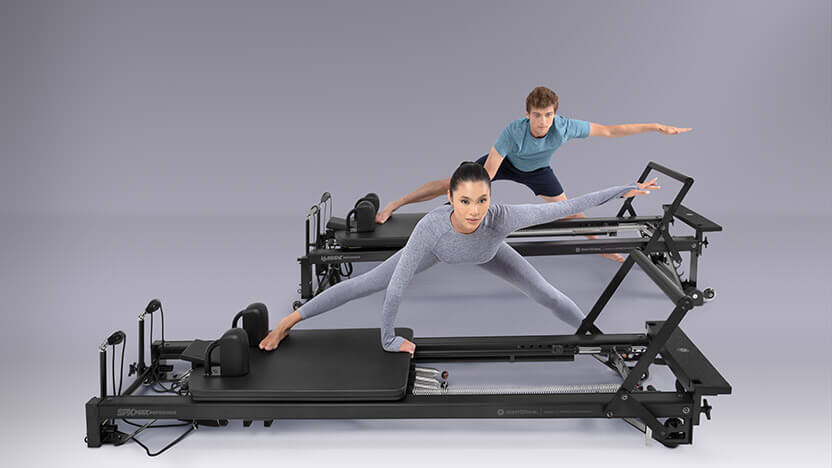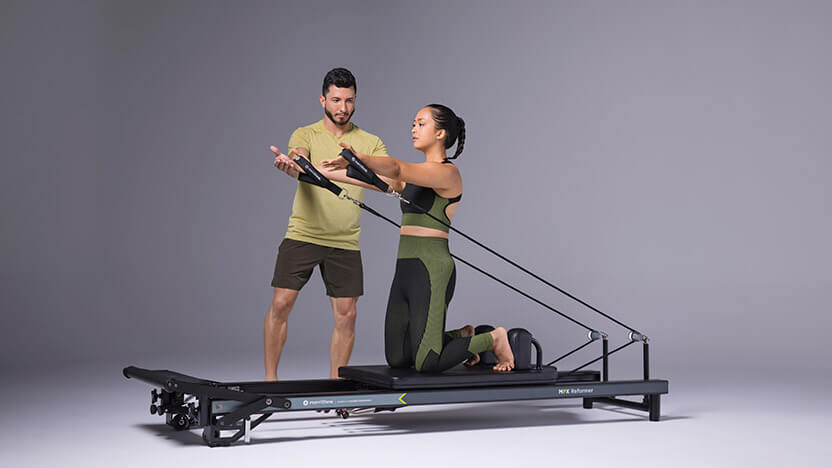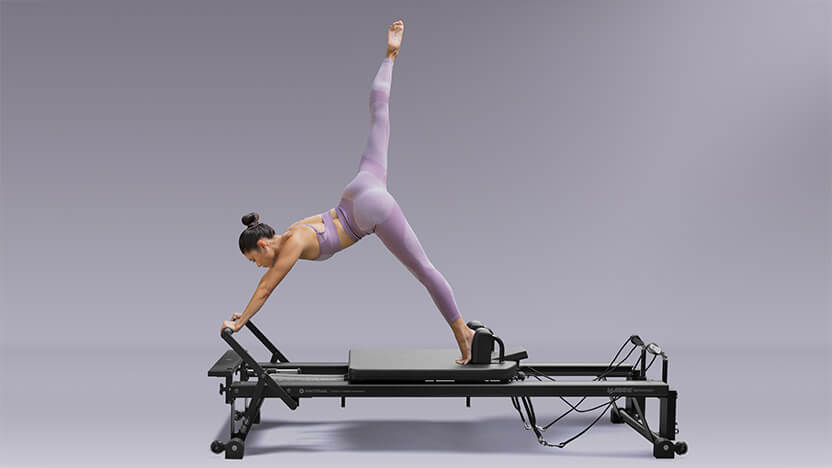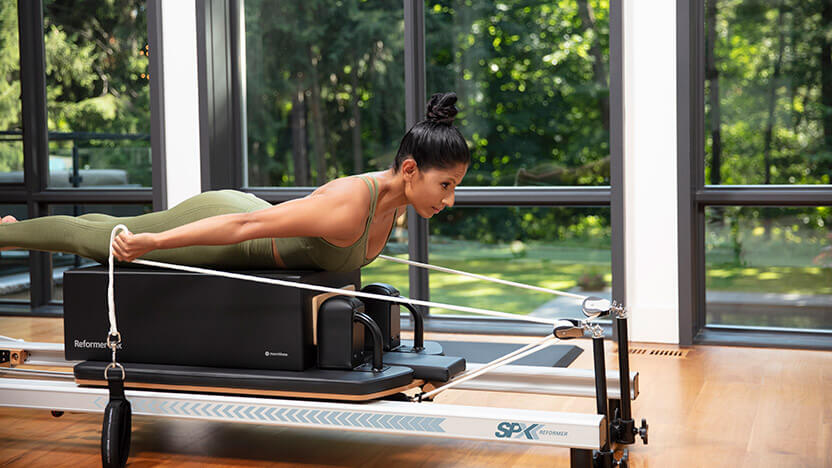Found in Pilates studios, fitness and franchise facilities, golf clubs, hotels and home gyms, and used by elite and recreational athletes, office workers, pre- and post-natal women, celebrities and rehab clients, the Pilates Reformer is one of the most versatile and effective exercise machines on the market.
The Pilates Reformer is a highly sought-after piece of equipment because it facilitates safe, versatile and low-impact workouts for the whole body using spring resistance. It’s suitable for people of all ages and fitness abilities looking to increase their strength, flexibility, balance, coordination, posture, muscle tone, range of motion, functional movement— and that’s just the beginning!
While most Pilates Reformers come with the same base features, there are a lot of upgrades to consider. Ultimately, no two Reformers are alike.
Some Reformers are more customizable with upgrades that can include custom colors to match your décor or branding, extensions for height, a Vertical Stand for upright storage, vinyl strap covers for easy cleaning, accessory boards, a Vertical Frame for a quasi-Cadillac experience, and so much more!
All of these factors are things to consider when investing in this type of exercise machine— whether you’re a home user, a fitness professional or a studio or fitness facility owner— you’ll want to think about how you’ll be using it, with whom, what size space you have, and what your budget is.
In our first-ever Pilates Reformer Buyers’ Guide, we’ll provide you with everything you need to know to find, choose and buy the best Reformer for your needs, fitness goals or studio space.
Menu:
- What is a Pilates Reformer?
- Pilates Reformer benefits: Why is a Reformer so effective?
- What’s the difference between mat Pilates and Reformer Pilates?
- Four questions to ask yourself before buying a Reformer
- Pilates Reformer key features and functionality
- Reformer upgrades and customization
- Reformer accessories
- Why invest in a Merrithew® Reformer?
- Tips on buying a Reformer – from fitness professionals
- How to choose the best Pilates Reformer for you
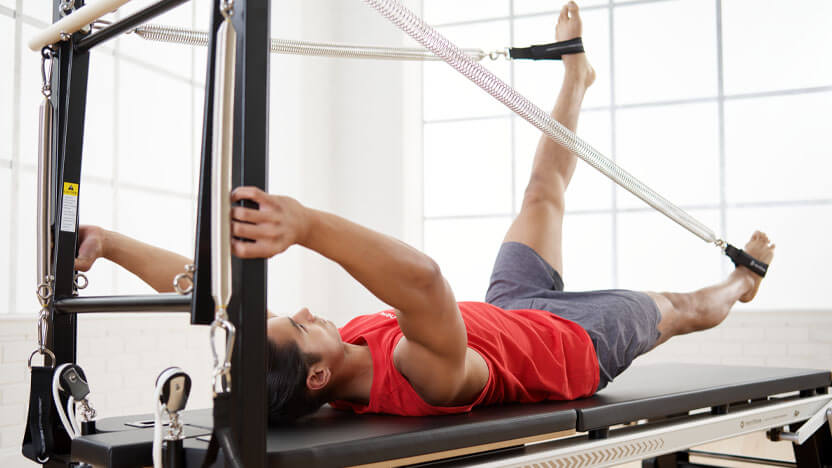
A Pilates Reformer is a traditional piece of Pilates equipment that uses spring resistance, a moving carriage platform, ropes and pulleys to provide resistive and assistive exercises for the whole body in all planes of motion.
The Reformer springs maintain tension through the full joint range and on the concentric and eccentric phases of the movement, challenging the user’s strength, stability, mobility, flexibility and balance.
The Pilates exercise method and the first iteration of the Reformer machine were both invented by Joseph Pilates in the early 1900s. It was his belief that “physical fitness is the first requisite of happiness.” His fitness program, called Contrology, aimed to restore and maintain flexibility of the spine through six principles: breathing, centering, concentration, control, flow and precision.
Merrithew®’s contemporary Pilates method, the STOTT PILATES® Movement System, has evolved over the last three decades, incorporating the latest exercise science and rehabilitation research and fitness training protocols. The STOTT PILATES Principles look at how different parts of the body, as well as optimal breathing patterns and mind-body awareness, function alone and in unison to affect posture, alignment, transfer of forces, muscular recruitment and activity.
The Pilates Reformer, which is one of the most popular exercise machines used for Pilates, has come a long way since the early 1900s with new innovations, functionality and customization, which we’ll explain in more detail below.
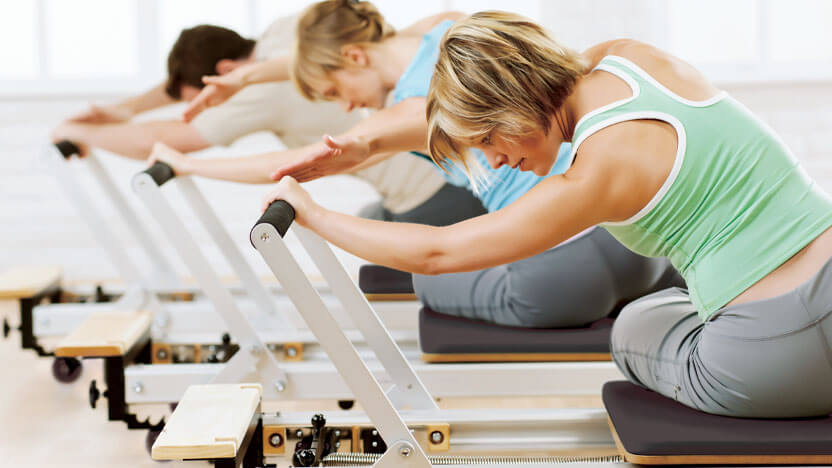
The Pilates Reformer offers many benefits to users, including an effective low-impact, full-body workout using spring resistance. Any Reformer workout can be progressed, regressed or modified depending on the user’s needs, fitness level, ability, and goals.
The Reformer’s spring system facilitates hundreds of exercise options that can be done by a wide range of users, including rehab patients, athletes, pregnant women, people with disabilities and mobility limitations, etc. The spring resistance can be altered depending on the user’s individual requirements, adding challenge or providing support.
On a Reformer, the user can remain in a comfortable position, including supine, prone, side-lying, standing, kneeling and sitting, while working out.
If the Vertical Frame (sometimes called a Tower) is added to the traditional Reformer, the angle of resistance can be adjusted to target individual muscles and muscle groups. These options increase the functional programming options for rehab patients, everyday users, and athletes.
Compared to conventional weight training, where a greater output of force is required to initiate the movement against gravity (think of a bicep curl), when using springs, the resistance begins at a lower level and gradually increases through the range of the motion. This means the greatest amount of resistance is achieved at the end of the range of movement, creating tension through the full joint range. Some exercises on the Reformer actually become more challenging when you decrease the support and stability provided by the springs.
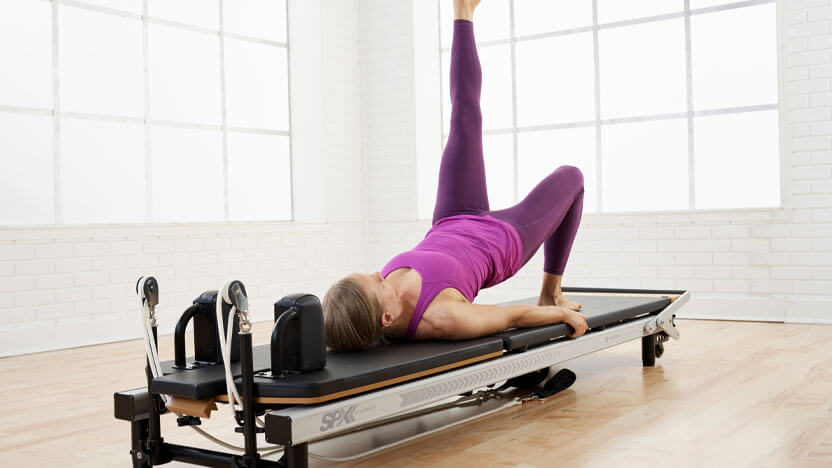
The main difference between these two forms of Pilates is that mat Pilates relies mainly on body weight and gravity, and Reformer Pilates uses springs, ropes and straps for added resistance.
Both provide safe and effective workouts that challenge strength, mobility, stability, and balance and emphasize proper form, alignment, control, breathing and the mind-body connection to improve how the body functions as a whole, integrated system.
Since mat Pilates can be done with just an exercise mat on the floor, it’s an affordable and accessible way to try, expand and advance your Pilates practice. It’s a great way to work the whole body without any additional props or equipment and is often taught at mainstream gyms, fitness clubs and community centers. But don’t be fooled – just because it’s done on a mat doesn’t make mat Pilates any less challenging than Reformer Pilates.
Many people enjoy the variety and excitement of working on exercise equipment and that’s one of the reasons they choose Reformer Pilates. By adjusting the spring resistance, the Reformer can be used to advance many Pilates exercises and increase the stability, endurance and strength challenge. The Reformer can also be used to modify mat Pilates exercises so users who can’t exercise on the floor, bear weight on certain parts of the body, or need the assistance of the springs, can still participate.
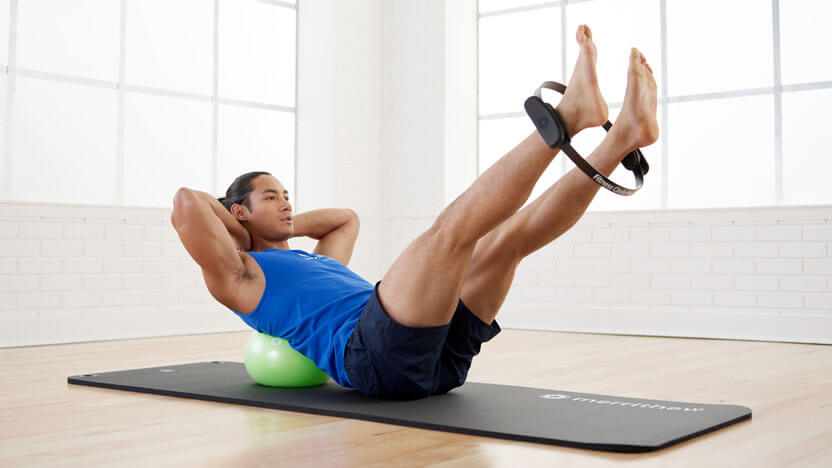
A. How will you be using the Reformer?
Will you be using the Reformer for group classes, private one-on-ones, home use, health care, or rehabilitation? Knowing your client base (or your own needs) will help you choose the best Pilates Reformer, whether that’s a professional Reformer with more accessory and programming options for a diverse clientele, or a more streamlined and competitively priced Reformer for personal home use.
B. Who will be using the Reformer?
Professional athletes, seniors, rehab patients, or yourself? Depending on the answer, this may change the Reformer you buy. For example, seniors and rehab patients may need an elevated Reformer carriage, so they don’t have to bend down to get on the equipment. Athletes may need a longer carriage bed if they’re taller or bigger than the average person. Home users likely want something versatile but compact for their home gym space.
C. What type of space do you have?
Reformers can be used in many different settings and come with special features to accommodate different size spaces. For example, if you have a multi-use gym or fitness facility, you may want to consider a Reformer with a stand or one that can be stacked and easily moved, whereas this feature wouldn’t matter as much for a studio owner or fitness professional with a designated space for the Reformer.
D. What’s your budget?
Reformers range in price from a few thousand dollars to $10,000 plus. It all depends on their functionality, features, warranty, add-ons and accessories. When buying a Reformer, look for sturdy and durable components, high-quality craftsmanship and manufacturing, and a comprehensive warranty for peace of mind. You want to ensure that you’re investing in a versatile piece of Pilates equipment that will last a lifetime.
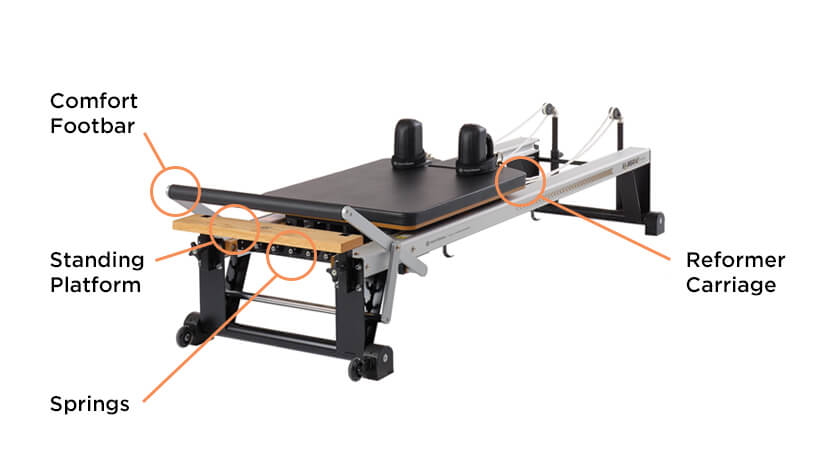
This diagram shows some of the basic components of a Pilates Reformer, including the Comfort Footbar, Standing Platform, Springs and Reformer Carriage.
All Reformers have the same basic components. Here are the four most important features to pay attention to when buying a Pilates Reformer.
Springs: A Reformer wouldn’t be what it is without its springs, so this is one of the most important features to inspect and research when buying a Reformer. You want to make sure you have a variety of spring tensions to provide different levels of resistance, that they’re made of high-quality and durable material, and can withstand continuous use.
Merrithew’s custom-crafted springs are nickel-plated and heat-treated, making them extremely safe and durable. They come with a unique spring ball that securely connects them to the gearbar.
Merrithew offers three springs packages:
- High-Precision Springs on all Professional models
- Traditional Springs on all At Home models
- Power-Up Springs as an additional upgrade for both Professional and At Home models
Merrithew is the only company to include Neoprene spring sleeves to eliminate noise, so users can remain in the zone as they exercise. The metal spring holders on Professional Reformers, and plastic spring holders on At Home models, keep the springs out of the way while not in use. We recommend that you replace your springs every two years to ensure optimal safety, performance and warranty coverage.

This image shows the three springs packages offered on Merrithew Reformers. They are: the High-Precision Springs, available on all Professional Reformer models during manufacturing; the Traditional Springs on all At Home Reformer models; and the Power-Up Springs, available as an additional upgrade for both Professional and At Home Reformer models.
Additional customization: The gearbar is the mechanism that holds the springs in place while in use. It also changes positions, providing additional adjustments. The Traditional Gearbar is standard on all Merrithew Reformers, providing three gearbar positions. Any new Professional Reformer purchase can be upgraded to the High-Precision Gearbar to get six gearbar positions, added versatility and improved precision. This can only be added to Professional models during production/manufacturing. Reformers cannot be retrofitted to add this feature later on.
| Spring |
Equivalent tension in lbs / kg |
| 100% Reformer spring: |
6-7.5 lbs (2.7-3.4 kg) |
| 50% Reformer spring: |
3-4 lbs (1.3-1.8 kg) |
| 25% Reformer spring: |
2.25-3.25 lbs (1-1.4 kg) |
| 125% Reformer spring: |
7-11 lbs (3.1-4.9 kg) |
Carriage: The carriage is a platform on wheels that attaches to the Reformer’s springs. This is what you will be sitting, standing or lying on as you push and pull the carriage along the Reformer’s rails. You want to look for a Reformer carriage that is sturdy, comfortable and supportive and doesn’t creak or feel rickety when you put your full weight on it.
Merrithew’s UVA foam-padded carriage is unique because of its patented whisper-smooth rolling mechanism. With two fixed wheels and two floating wheels, the carriage rolls smoothly and quietly across the aluminum rails no matter how vigorous the workout.
Comfort for everyone: SPX® Max Reformers feature a 22 in (55.9 cm) wide carriage, while V2 Max™ Reformer models have a wider 24 in (61 cm) carriage. A 6 in (15 cm) carriage extension upgrade is also available on certain Reformer models for those looking to accommodate clients 6 ft 4 in (193 cm) or taller.
Rope system: Ropes or straps are another core component of any Reformer and should be adjustable to suit the user’s specific needs. They usually have handles or loops at the end and provide additional exercise options for the arms and legs. These ropes allow users to work through greater ranges of motion as the Reformer carriage moves, challenging stability and control for a multi-dimensional workout.
Warranty: When investing in something like a Reformer, you want to be sure it comes with a comprehensive warranty. Look for a warranty that covers components and mechanisms, welding, fabric and upholstery, and wear and tear.
Beyond the conventional Reformer features mentioned above, there are myriad ways to customize and upgrade your Reformer depending on your studio needs, clientele, space or fitness goals.
Do you teach a lot of athletes and need a larger carriage or an extra-long Reformer Box? Done.
Do you want a Reformer in Millennial pink to match your home decor or studio branding? The choice is yours with upholstery available in 10 standard or 75 custom colors.

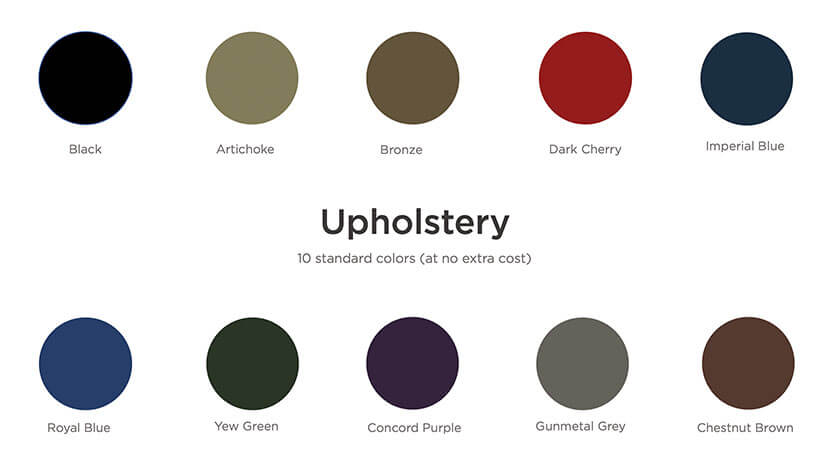
Get a Reformer in your favorite color: our upholstery is available in 10 standard colors at no extra cost, including Dark Cherry, Bronze, Concord Purple and Artichoke. We offer 75 custom colors for an additional charge.
One of the most popular upgrades on Merrithew Professional Reformers is the Vertical Frame and Mat Converter, which transform the Reformer into a quasi-Cadillac. With these additions, users can perform 80% of Cadillac exercises on one Reformer machine. This is handy for small studios that can’t fit both machines, but still want to offer both Reformer and Cadillac programming.
The Vertical Frame provides a number of additional spring options and the Mat Converter turns the Reformer into a raised mat platform, on which mat Pilates exercises can be done for those with limited mobility.
The Vertical Frame is only available on Merrithew Professional Reformer models.
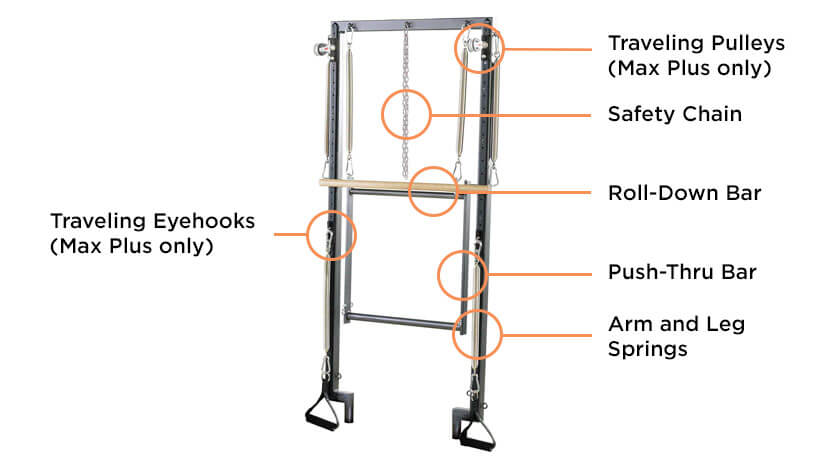
The Vertical Frame can be added to Merrithew Professional Reformer models, transforming the Reformer into a quasi-Cadillac. Here we show some of the key components of the Vertical Frame, including the Traveling Pulleys (Max Plus models only), Safety Chain, Roll-Down Bar, Push-Thru Bar, Arm and Leg Springs, and Traveling Eyehooks (Max Plus models only).
The Reformer is a great piece of equipment on its own, but it can also be enhanced with additional accessories to provide even more exercise and programming options.
Some of the most popular Merrithew Reformer accessory boards that can be added to Professional Reformer models include:
Cardio-Tramp® Rebounder – exclusive to Merrithew, this accessory transforms Professional Reformers into a heart-pumping cardio machine and provides a shock-absorbing surface for plyometric activity, making rebounding exercises easier on the joints. Other brands offer padded boards or a BOSU® on a board as an alternative soft landing surface.
Jumpboard – this is very similar to the Cardio-Tramp Rebounder except it provides a firm, padded jumping surface for plyometric and aerobic exercise.
Rotational Diskboard – this is used for rotational exercises in both the upper and lower body. The disks can be moved into multiple positions for a range of exercise options and are often paired with other props, like Stability Cushions™, to improve ankle strength and mobility. This tool is ideal for rehabilitation and for clients with limited range of motion.
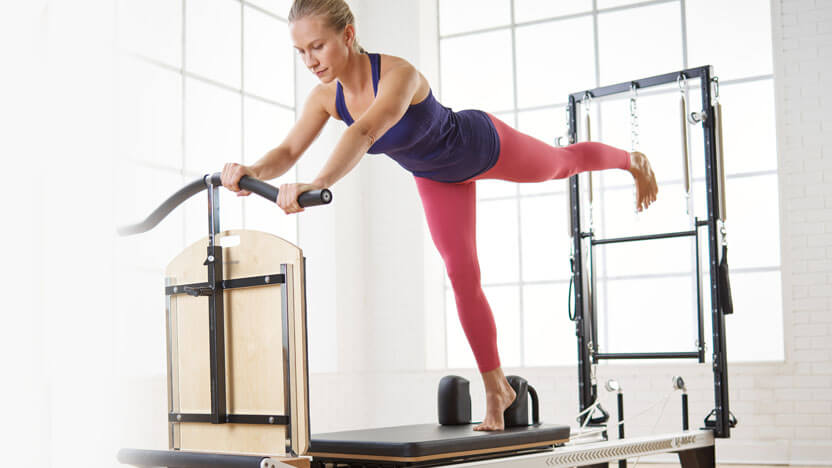
Cross-Bow™ – connects easily to a Jumpboard and provides a range of secure grip positions to accommodate a variety of individuals. It’s a great support tool to help with balance and assist with upper body support and stability.
Vinyasa Triangle™ – this is another exclusive Merrithew offering that’s used in our ZEN•GA® programming and can support the arms and legs while performing ZEN•GA or yoga-inspired exercises. This can only be used on Reformers with removable shoulder rests, so not on the At Home Reformer models.
Versatility:
Merrithew Reformers come in a variety of models for home users, fitness professionals, studio owners and health care professionals.
Our Reformers are designed to accommodate diverse client needs with at least three gearbar positions, three headrest positions, four footbar positions and six carriage stopper positions.
Merrithew Reformers are highly adjustable and customizable, providing users with hundreds of exercise and programming options.
Quality:
Merrithew’s Professional line of Reformers are manufactured in Canada using the highest quality materials. Our Reformers are built to withstand continuous, high-intensity studio use and come with a comprehensive warranty.
Merrithew’s equipment is known as ‘The Professional’s Choice’ for its high manufacturing standards and fine craftsmanship. This durability helps Merrithew Reformers retain their value for years after purchase.
Performance:
Merrithew Reformers are versatile, durable and designed for safety and effectiveness. Due to their quality, durability, reliability and longevity, they’re used in professional settings around the world, including professional sports centers, health care clinics/hospitals, fitness facilities, spas, hotels, and more.
Innovation:
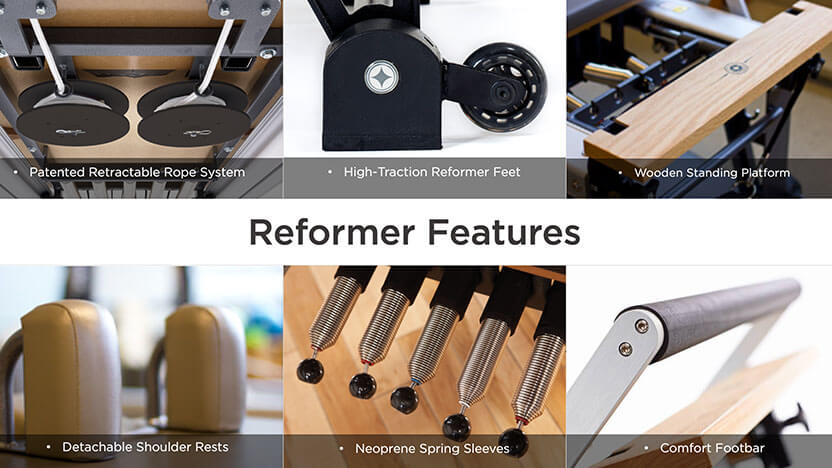
Some of the key features of Merrithew Reformers include: the Patented Retractable Rope System, High-Traction Reformer Feet, Wooden Standing Platform, Detachable Shoulder Rests, Neoprene Spring Sleeves and Comfort Footbar.
Three main patented features set Merrithew Reformers apart from others on the market:
The retractable rope system enables quick and easy rope length adjustments between exercises and clients for an uninterrupted workout.
The fixed/floating roller system allows the Reformer carriage to glide quietly and efficiently along the length of the rails, providing the smoothest carriage ride.
The traveling pulley system on the Vertical Frame provides multiple angles of resistance to facilitate greater range of motion, creating a multi-dimensional workout. By sliding the quick set pulleys up and down on the Vertical Frame, you can completely change the targeted muscle groups and allow clients to isolate specific areas for a very precise workout.
Certain features and accessories, such as the High-Precision Gearbar, high-traction Reformer feet, Cardio-Tramp Rebounder and Vinyasa Triangle, are all exclusive and unique to Merrithew Reformers.
Warranty:
Merrithew offers one of the best warranties in the industry with a limited lifetime warranty on a number of components.
Warranty on all new Merrithew Reformer models:
- Limited lifetime warranty on aluminum rails, components of the frame and related welding, and footbar mechanisms (excluding the Comfort Footbar)
- 90-day limited warranty on fabric and upholstery
- 1-year limited warranty on wear and tear items, including: Ropes, rollers, straps, spring clips, plastic pulley bar receptacle sleeves, Comfort Footbar covering, plastic Reformer feet, spring O-rings, molded spring holder and spring covers
- 2-year limited warranty on all other Reformer components
Note about the At Home SPX® Reformer: If this Reformer is used in Pilates studios, fitness or health clubs, gyms, spas, or any other type of commercial facility offering fitness services to the public, the warranty becomes null and void.
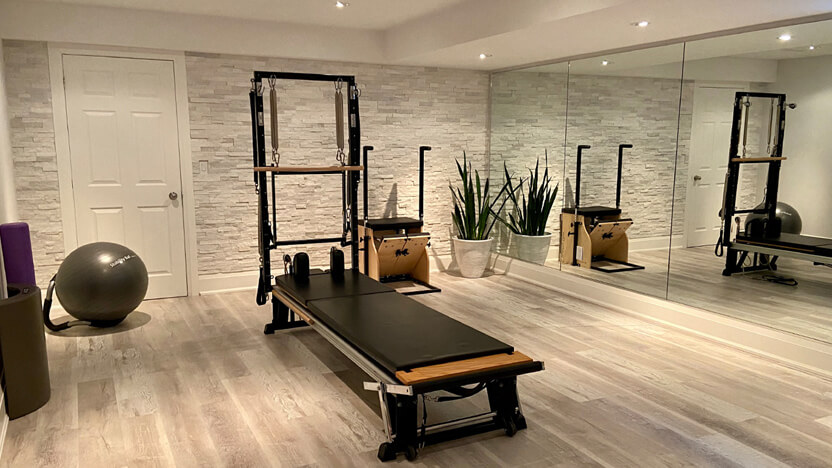
Adriana Rotella, Merrithew Lead Instructor Trainer and studio owner in Toronto, Canada
“If looking for a Pilates Reformer machine for home use, consider a model that can be easily stored. Home Pilates Reformers are usually more compact and have conveniences like wheels, so they can be easily maneuvered, tucked under a bed or pushed aside.
“If looking for a Professional Pilates Reformer model for studio use or private clients, consider the general size and specific needs of your clients (e.g. football, hockey or basketball players would require a longer Reformer with extra support), special populations, such as elderly clients in a rehab setting, may find it difficult to get down on to a lower Reformer. You should also consider the size of your studio space. Will the same space be used for Pilates mat or other fitness classes, meaning the Reformers would have to be moved and put away?
“At the end of the day, the most important thing is to look for and invest in quality. A good quality Reformer can provide client sessions for well over 20 years!”

Regina De Los Reyes, STOTT PILATES Full Certified Instructor at Fit to Live Studio, Philippines; TaskHuman Wellness Coach and Community Lead
“Investing in your own Reformer is a great experience. Choose a Reformer that you’re already familiar with from your instructor training or that you’ve used in class, so that you know how to adjust the settings. Identify the type of Reformer you want to have. Will it be a standard Reformer, or will it be a Reformer with a Vertical Frame or Tower? Which accessories do you want to add?
“The Reformer should have a solid and sturdy construction with manageable maintenance. Measure your floor space and ceiling clearance so that you know your Reformer will fit accordingly. Look for a manufacturer that gives you value for money, plus excellent customer service, including shipping terms. Inquire about the available spare parts and the typical wear-and-tear lifespan of the Reformer. Ask for any promotions or bundles that you can enjoy with your purchase.”
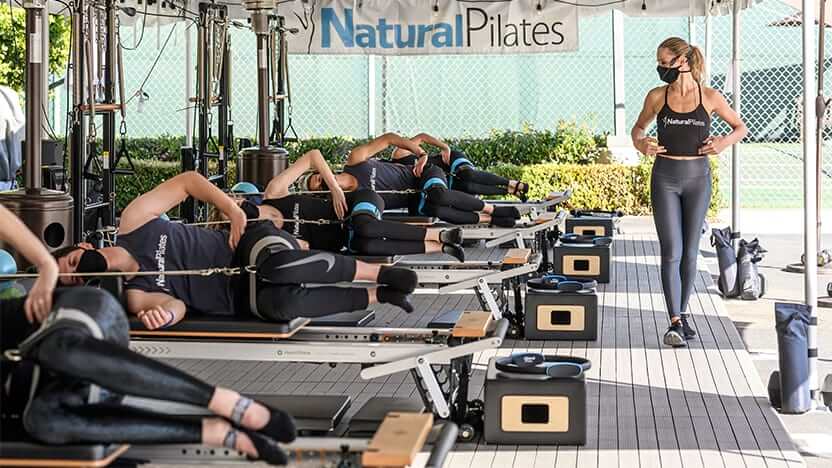
Laura Wilson, STOTT PILATES Certified Instructor and owner of Natural Pilates in Los Angeles, California
“I’ve always and will always train on Merrithew Reformers because of the outstanding quality of these Pilates machines and the consistency and sturdiness of the springs, which make for a better workout. The Merrithew color selection is great because you can match your Pilates machines with the branding and decor of your studio. Merrithew Reformers are my favorite Reformers compared to all the others I’ve tried.”
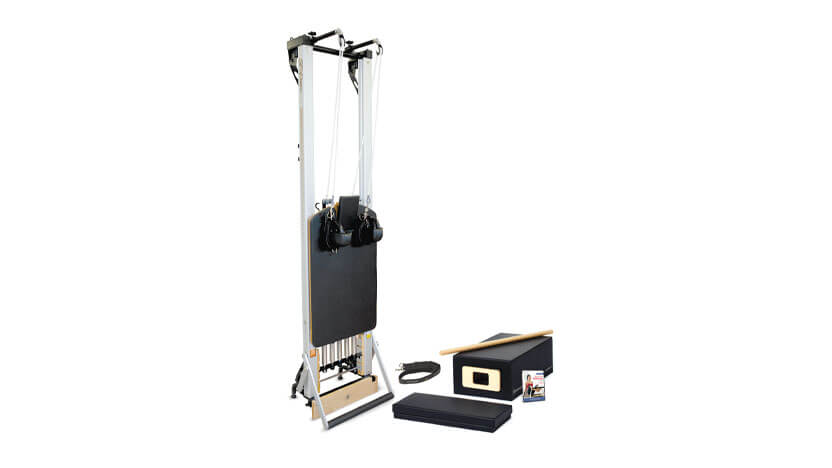
SPX® Max Reformer with Vertical Stand Bundle – This Reformer is fully loaded with our beloved commercial features, while also offering the added bonus of a Vertical Stand for space-saving convenience. The regular SPX Max Reformer (without Vertical Stand) can be stacked five high.
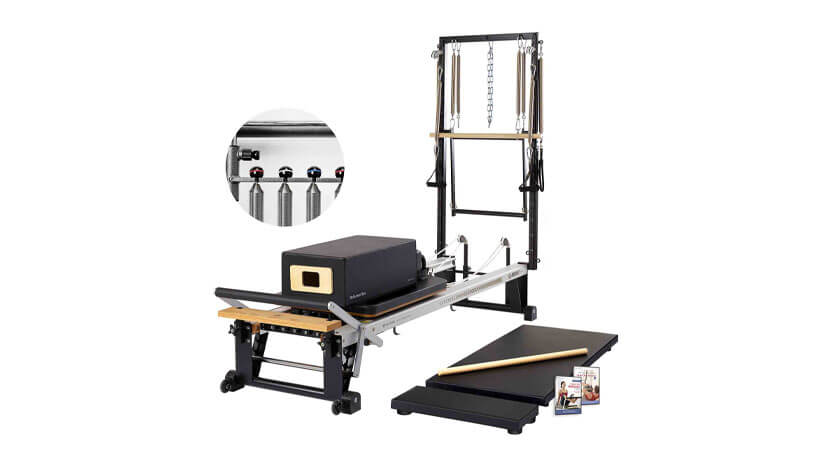
V2 Max Plus™ Reformer Bundle with High-Precision Gearbar – The ‘Cadillac’ of our Reformer line, the V2 Max Plus Reformer facilitates limitless exercise possibilities. This one-of-a-kind unit multi-tasks as a raised mat platform, a standard Reformer, a quasi-Cadillac and a breakthrough multi-planar, biomechanics training tool.
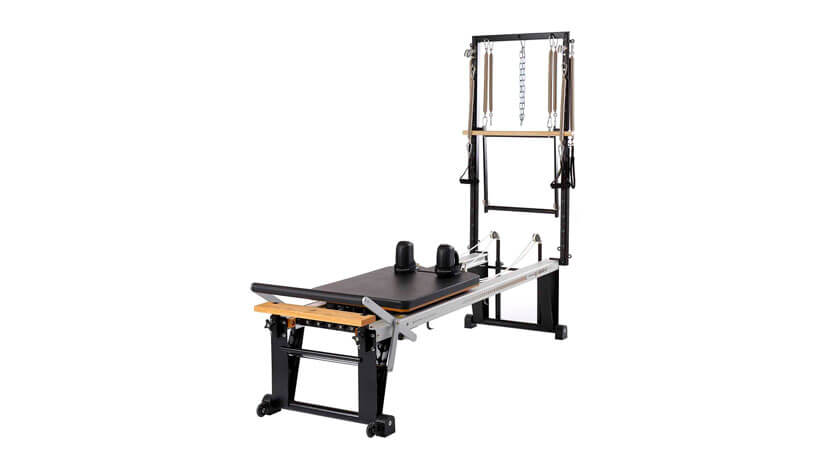
Rehab V2 Max™ Plus Reformer – Offering a higher carriage platform for clients with limited mobility and to support the demands on practitioners, this Reformer with Vertical Frame is highly versatile and adaptable for facilities with rehab patients and/or fitness clients. The Reformer can double as a treatment table with the use of a Mat Converter.
Shop Reformers >
Source: https://www.merrithew.com/blog/post/2021-09-27/2022-pilates-reformer-buyers-guide-how-to-choose-the-best-pilates-reformer-for-your-needs-fitness-goals-and-studio-space#menu1
